| |
| |
Photographer,
Location |
Images |
Comments |
|

|
David Headland,
Oamaru, South Island, New Zealand
Jan. 22, 2007 |
#1,
#2 |
Photo
details: Canon
EOS 20D, 70mm
lens, photo 1: 25s f/2.8 3200ISO photo 2: 6s f/2.8 1600ISO
photo 3: 6s f/3.5 800ISO
|
|

|
Minoru
Yoneto,
Cromwell, New Zealand
Jan. 23, 2007 |
#1,
#2, #3,
more |
Comet
McNaught swims in a night sky without setting in the horizon
from today. Please give me enough sleeping time! |
|
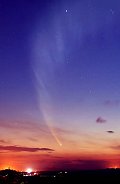
|
Phillip
Holmes,
Rockhampton Australia taken with canon 300D 28-90mm lens
Jan. 21, 2007 |
#1 |
This
is my best photo of the comet, taken with a Canon
300D. |
|

|
John Wang,
Birdlings Flat, Banks Peninsula, Canterbury, New Zealand.
Jan. 22, 2007 |
#1,
#2, #3,
#4 |
Wow~ amazing
Comet MacNaught over Banks Peninsula!
Photo
details: Canon
EOS 30D, Canon
EF-S 17-85mm lens
|
|

|
Peter Terren,
Bunbury Australia
Jan. 22, 2007 |
#1,
more |
The huge fan
is visible far more than the naked eye can see in this 3
minute exposure with a Nikon
D70s.
|
|
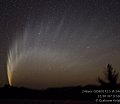
|
Grahame
Kelaher,
Mudgee Observatory, Mudgee, NSW, Australia
Jan. 22, 2007 |
#1,
more |
Comet
McNaught became visible at around 8:50pm, with the tail
setting just after midnight! These shots were taken at Mudgee
Observatory with a Canon
20D |
|
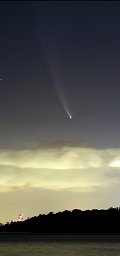
|
Geoff
Sims,
Manly, Sydney, Australia
Jan. 22, 2006 |
#1,
#2, #3,
#4 |
Despite
the city glow, McNaught's comet was clearly visible to the
unaided eye.
Photo
details: Olympus
C-5050, ISO 64, ~16s exposure at at f/2.8 |
|
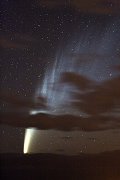
|
Dave
Curtis,
Dunedin, New Zealand
Jan. 23, 2007 |
#1 |
I
took this image from the backdoor step just after midnight.
The comet was so bright I could see it through clouds from
inside the house and the inside lights were still on.
Photo
details: Canon
1D Mrk2, 70-200
mm lens, f/2.8, 30sec exposure |
|
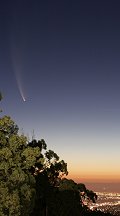
|
John
Golja,
Mt Dandenong, Melbourne, Australia
Jan. 22, 2007 |
#1,
#2 |
The
comet was first spotted around 9:20pm local time (10:20UT)
during twilight over the south-west. As the night progressed,
the comet's tail became more visible to the crowd of around
100 at the Mt Dandenong Observation Deck. By 10:30pm it
was spanning an estimated 20 degrees vertically over the
night sky!
Photo
details: Canon
EOS 400D, 50mm(80mm equiv.) at f2.8 4-30 sec ISO400
22/1/2007 9:44pm AEDT (10:44UT) |
|
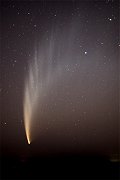
|
Peter
Hammer,
Beaumaris, Melbourne, Australia
Jan. 22, 2007 |
#1 |
Luckily
the comet appeared over the darkest part of the sky where
there were no background lights although being in a city
there is a lot of scattered light. The orange glow has been
partially removed although you can still see it towards
the bottom of the image. |
|
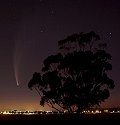
|
Trevor
Mackie,
the western suburbs of Mebourne, Australia
Jan. 22, 2007 |
#1,
#2 |
Photo
details: Taken with Hutech modded 5d and Canon
400D, 28-105mm lens at 28mm. Exposures from 50-90 seconds.
|
more
images: from
Ian Brunton of Orange, New South Wales, Australia; from
Luis Alberto Mansilla of Rosario, Argentina; from
Patrick Ridgway of Gordons Bay South Africa; from
Nico
Rennis of Buenos Aires, Argentina; from
Mauritz Geyser located 40km west from Pretoria, South Africa;
from Diego Vallmitjana
of Bariloche, Patagonia, Argentina; from
Harry Peters of Scarborough Beach, Cape Peninsula, South Africa;
|
|